St. Luke's Church, Munich
St. Luke's Church (German: St. Lukas or Lukaskirche) is the largest Protestant church in Munich, southern Germany. It was built in 1893–96, designed by Albert Schmidt. It is the only preserved Lutheran parish church in the historical area of Munich.
| St. Luke's Church | |
|---|---|
| |
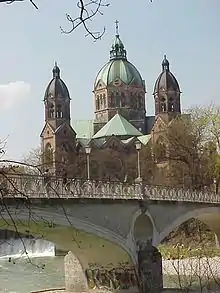 St. Luke's on the banks of the Isar | |
 St. Luke's Church Location within Bavaria | |
| 48°08′06″N 11°35′14″E | |
| Location | Munich |
| Country | Germany |
| Denomination | Lutheran |
| Website | www |
| History | |
| Status | parish church |
| Dedication | Luke the Evangelist |
| Dedicated | first Advent 1896 |
| Architecture | |
| Functional status | active |
| Architect(s) | Albert Schmidt |
| Style | historiscism |
| Groundbreaking | 29 June 1893 |
| Completed | first Advent 1896 |
| Specifications | |
| Dome height (outer) | 64 m (210 ft) |
| Number of spires | 2 |
| Materials | Brick |
| Bells | 2 (4[lower-alpha 1]) |
| Administration | |
| Parish | Lukasgemeinde Munich |
| Deanery | Munich and Upper Bavaria (Kirchenkreis) |
| Synod | Lutheran Church in Bavaria |
St. Luke's is located on the banks of the Isar, between the Steinsdorfstraße and Mariannenplatz. Although the ground belongs to Mariannenplatz (Mariannenplatz 3), the main entrance is found at the Steinsdorfstraße. The two east towers and the almost 64-meter high dome are prominent features. Although St. Luke's is nicknamed Dom der Münchner Protestanten (Cathedral of the Munich Protestants), the church is not a seat of a bishop.
History and description
The history of the Protestant church in Munich is rather short. The first Protestant groups early in the 16th century were banned and suppressed. Bavaria was a predominantly Catholic kingdom under the reigning Wittelsbach family from the time of the Reformation, but in 1799 the Wittelsbach head, Prince-elector Max IV Joseph married Friederike Karoline Wilhelmine; a Lutheran princess, and there was suddenly a Protestant presence at court in Munich. 19th century Munich also became a city with a growing number of immigrants from other regions of Germany, many of them Lutherans.[1]
In 1826, there were already 6,000 Lutheran parishioners in the city. The first Protestant church, St. Matthew, was inaugurated in 1833. It was demolished in 1938 by the Nazis and rebuilt after the World War II in another location. The second Protestant church, St Mark's, was inaugurated in 1877. By the last decades of the 19th century, Munich's Lutherans were in need of a third, and larger church. But the Bavarian royal family was concerned to protect the Catholic character of the city, therefore the Lutherans were given land on the banks of the river Isar to build St. Luke's. The first stone was laid on 29 June 1893 and the church was consecrated on the first Advent, 1896.[2]
Architecture and art
The architect Albert Schmidt has used pre-Reformation styles in order to please the Roman Catholic city rulers: The exterior architecture is built in Romanesque forms, while the interior is reminiscent of the early Rhenish Gothic based on the geometric shape of a Greek cross. In the east there is a three-sided apse, the western facade is seven-sided and has square towers.[3]
St. Luke's had some artistically outstanding stained glass windows from 1896–99, which had been created by the München Mayer'sche Hofkunstanstalt (Mayer's court art workshop Munich) after drafts of the Englishman Charles Dixon, one of the best-renowned glass painter of his time.
Those windows were destroyed irretrievably during the great air raid of 6/7 September 1943. The lost windows of the chancel were replaced by new ones by Hermann Kaspar in 1946. The altar painting is a work of the artist Gustav Adolf Goldberg, which is dedicated to the Entombment of Christ.
Organ
The organ was built in 1932 by the G.F. Steinmeyer & Co. (Oettingen).[4]
Gallery
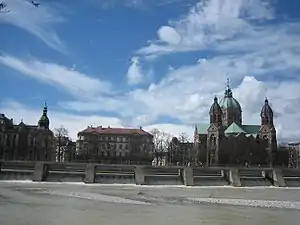 Weir on the River Isar with St. Luke's
Weir on the River Isar with St. Luke's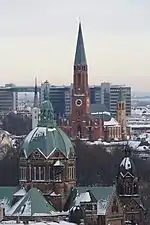 St. Luke's with the Roman Catholic church of St John the Baptist in the background
St. Luke's with the Roman Catholic church of St John the Baptist in the background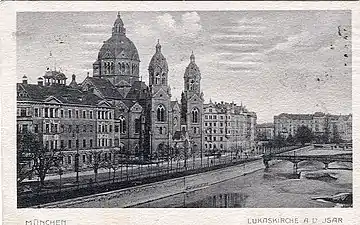 St. Luke's in 1918
St. Luke's in 1918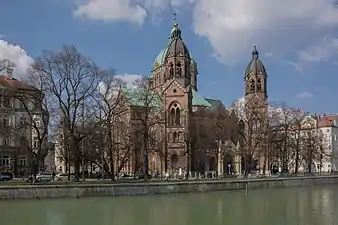 Exterior
Exterior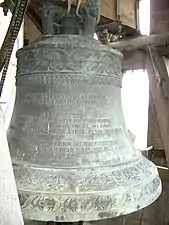 Inscriptions Bell, 1862
Inscriptions Bell, 1862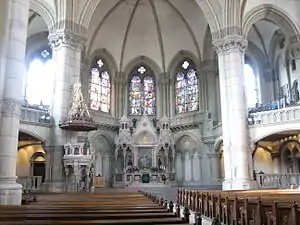 Interior
Interior Organ
Organ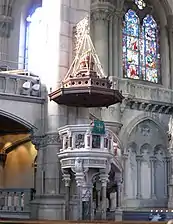 Pulpit
Pulpit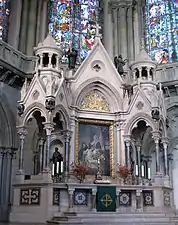 Altar
Altar
Notes
- Two bells hung are only on loan, one, the Inscriptions Bell, cast in 1862 on behalf of the presbytery of the then Lutheran St. Mary's Church, Stargard, the other cast in 1703 on behalf of the presbytery of the then Lutheran church of Schönwaldau, both were recovered chattels of the former congregations which else lost their church buildings in what is now Poland.
References
- "St Lukas: Munich's oldest Lutheran church". Nerd In Deutschland. 4 July 2012. Retrieved 21 June 2018.
- Killy, W.; Vierhaus, R. (2011). Schmidt – Theyer. Deutsche biographische Enzyklopädie. Walter de Gruyter GmbH. p. 2. ISBN 978-3-11-096629-9. Retrieved 21 June 2018.
- Schacherl, L.; Biller, J.H. (1987). Munich. Prestel Guides (in German). Prestel-Verlag. p. 154. ISBN 978-3-7913-0838-8. Retrieved 21 June 2018.
- "Gerd Kötter". gerdkoetter.de (in German). 21 June 2003. Archived from the original on 21 June 2003. Retrieved 21 June 2018.
As of this edit, this article uses content from "St. Lukas", which is licensed in a way that permits reuse under the Creative Commons Attribution-ShareAlike 3.0 Unported License, but not under the GFDL. All relevant terms must be followed.